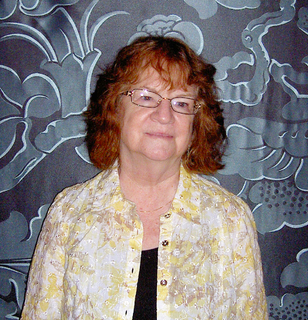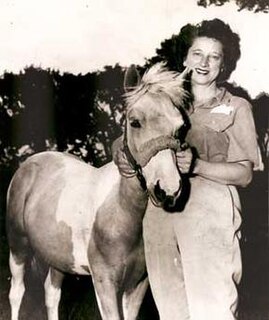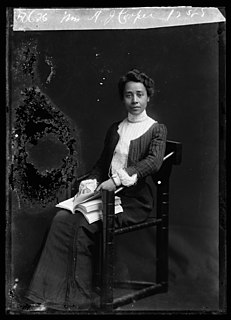Related Research Articles

Helen Beatrix Potter was an English writer, illustrator, natural scientist, and conservationist. She is best known for her children's books featuring animals, such as The Tale of Peter Rabbit.

Helen Adams Keller was an American author, disability rights advocate, political activist and lecturer. Born in West Tuscumbia, Alabama, she lost her sight and her hearing after a bout of illness at the age of 19 months. She then communicated primarily using home signs until the age of seven, when she met her first teacher and life-long companion Anne Sullivan. This young woman taught Keller language, including reading and writing. After an education at both specialist and mainstream schools, Keller attended Radcliffe College of Harvard University and became the first deafblind person to earn a Bachelor of Arts degree.

Joanne Rowling, also known by her pen name J. K. Rowling, is a British author and philanthropist. She wrote a seven-volume children's fantasy series, Harry Potter, published from 1997 to 2007. The series has been enormously successful: it has sold over 500 million copies, been translated into at least 70 languages, and spawned a global media franchise including films and video games. The Casual Vacancy (2012) was her first novel for adults. She writes Cormoran Strike, an ongoing crime fiction series, as Robert Galbraith.

Alice's Adventures in Wonderland is an 1865 English novel by Lewis Carroll. A young girl named Alice falls through a rabbit hole into a fantasy world of anthropomorphic creatures. It is seen as an example of the literary nonsense genre.

Laura Elizabeth Ingalls Wilder was an American writer, mostly known for the Little House on the Prairie series of children's books, published between 1932 and 1943, which were based on her childhood in a settler and pioneer family.

Erin Patria Margaret Pizzey is an English ex-feminist and men's rights advocate, domestic abuse advocate, and novelist. She is known for having started the first and currently the largest domestic violence shelter in the modern world, Refuge, then known as Chiswick Women's Aid, in 1971.

Patricia Anne McKillip was an American author of fantasy and science fiction. She has been called "one of the most accomplished prose stylists in the fantasy genre", and wrote predominantly standalone fantasy novels. Her work won numerous awards, including the World Fantasy Award for Lifetime Achievement in 2008.

Elizabeth Corbet Yeats, known as Lolly, was an Anglo-Irish educator and publisher. She worked as an art teacher and published several books on art, and was a founder of Dun Emer Press which published several works by her brother W. B. Yeats. She was the first commercial printer in Ireland to work exclusively with hand presses.
A fore-edge painting is a scene painted on the edges of book pages. There are two basic forms, including paintings on fanned edges and closed edges. For the first type, the book's leaves must be fanned, exposing the pages' edges for the picture to become visible. For the second closed type, the image is visible only while the book is closed.

The Lady with an Ermine is a portrait painting widely attributed to the Italian Renaissance artist Leonardo da Vinci. Dated to c. 1489–1491, the work is painted in oils on a panel of walnut wood. Its subject is Cecilia Gallerani, a mistress of Ludovico Sforza, Duke of Milan; Leonardo was painter to the Sforza court in Milan at the time of its execution. It is the second of only four surviving portraits of women painted by Leonardo, the others being Ginevra de' Benci, La Belle Ferronnière and the Mona Lisa.

Marguerite Henry was an American writer of children's books, writing fifty-nine books based on true stories of horses and other animals. She won the Newbery Medal for "King of the Wind", a 1948 book about horses and she was a runner-up for two others. One of the latter, Misty of Chincoteague (1947), was the basis for several sequels and for the 1961 movie Misty.

Anna Julia Haywood Cooper was an American author, educator, sociologist, speaker, Black liberation activist, and one of the most prominent African-American scholars in United States history.

Helen Allingham was a British watercolourist and illustrator of the Victorian era.

The Tale of Jemima Puddle-Duck is a children's book written and illustrated by Beatrix Potter. It was first published by Frederick Warne & Co. in July 1908. Potter composed the book at Hill Top, a working farm in the Lake District she bought in 1905. Following the purchase, her works began to focus on country and village life, incorporating large casts of animal characters and sinister villains. Jemima Puddle-Duck was the first of her books set wholly at the farm with background illustrations based on the farm buildings and yard, and nearby locales.

The Story of Miss Moppet is a tale about teasing, featuring a kitten and a mouse, that was written and illustrated by Beatrix Potter, and published by Frederick Warne & Co for the 1906 Christmas season. Potter was born in London in 1866, and between 1902 and 1905 published a series of small-format children's books with Warne. In 1906, she experimented with an atypical panorama design for Miss Moppet, which booksellers disliked; the story was reprinted in 1916 in small book format.

Retta Scott was an American artist. She was the first woman to receive screen credit as an animator at the Walt Disney Animation Studios.

Edith Simon was a German-born British artist, author, sculptor, and historian active mainly in Edinburgh.
Events from the year 1934 in Scotland.
Helen Roney Sattler was an American children's author most famous for her award-winning books about dinosaurs.
Patricia Lauber Frost was an American Newbery Honor-winning author of Volcano: The Eruption and Healing of St. Helens (1986). During her writing career, Lauber wrote over a hundred children's books from the 1950s to the 2000s. Outside of writing, she was the chief editor in science for Science World, from 1956 to 1959, and for The New Book of Knowledge, from 1961 to 1967.
References
- ↑ Weber, Jeff, Annotated Dictionary of Fore-edge Painting Artists & Binders, Los Angeles, 2010, pp. pp.169-174.
- ↑ Connelly, William. "The Life and Work of Helen Haywood (1907-1995)." IBIS Journal 3 - Diverse Talents (2009): 98-143.
- ↑ Weber, Jeff, Annotated Dictionary of Fore-edge Painting Artists & Binders, Los Angeles, 2010, pp. pp.169-174.
- ↑ "Rare Books: Burke Fore-edge". Columbus College of Art and Design. Retrieved 16 February 2019.
- ↑ Gertz, Stephen J. (3 October 2012). "The Binding Paintings of Helen R. Haywood". Booktryst. Retrieved 16 February 2019.
- ↑ Weber, Jeff, Annotated Dictionary of Fore-edge Painting Artists & Binders, Los Angeles, 2010, pp. pp.169-174.
- ↑ Critic (8 December 1939). "Some New Books - Interesting Reading for West-Country Folk". Exeter and Plymouth Gazette. p. 5. Retrieved 15 February 2019.
- ↑ "Books as Yuletide Gifts". Belfast News-Letter. 9 December 1939. p. 10. Retrieved 15 February 2019.
- ↑ "Christmas Books". The Age. Melbourne, Australia. 22 November 1940. p. 13. Retrieved 14 February 2019.
- ↑ "Orient and Occident". The Scotsman. 5 December 1940. p. 2. Retrieved 16 February 2019.
- ↑ "Realms of Fancy". The Scotsman. 5 December 1940. p. 4. Retrieved 14 February 2019.
- 1 2 "For Younger Readers - Forest Folk; Nature Study". The Scotsman. 25 November 1943. p. 7. Retrieved 16 February 2019.
- ↑ "Stories and Pictures". The Scotsman. 23 November 1944. p. 6. Retrieved 14 February 2019.
- ↑ "For Younger Children". The Guardian. London, England. 24 June 1952. p. 3. Retrieved 14 February 2019.
- ↑ Reviews of Hedgehog's Holiday:
- Farjeon, Eleanor (4 December 1938). "Authors v. Artists". The Observer. London, England. p. 18. Retrieved 14 February 2019.
- Sharp, Evelyn (9 December 1938). "Best of Both Worlds". The Guardian (Supplement to the Manchester Guardian). p. XIV. Retrieved 14 February 2019.
- ↑ Culpepper, Donnell (24 October 1974). "All Outdoors - Good season seen for chukar, quail". The Independent. Longbeach, California. p. C8. Retrieved 15 February 2019.
- ↑ Bookman (13 December 1926). "Christmas Reading - More Children's Books". Sheffield Independent. p. 7. Retrieved 15 February 2019.
- ↑ "Children's Books". Yorkshire Post and Leeds Intelligencer. 1 December 1926. p. 5. Retrieved 14 February 2019.
- ↑ O'Brien, E.D. (8 December 1951). "Books of the Day For the Christmas Holidays". Illustrated London News. p. 41. Retrieved 14 February 2019.
- ↑ Edgar, Lois (September 1966). "Reviewed Work: The New Noah's Ark of Rare Animals. by Helen Haywood". The Quarterly Review of Biology. The University of Chicago Press. 41 (3): 308. doi:10.1086/405065. JSTOR 2819943.
- ↑ Lewis, Naomi (18 April 1965). "Books for Children". The Observer Weekend Review. London, England. p. 26. Retrieved 14 February 2019.